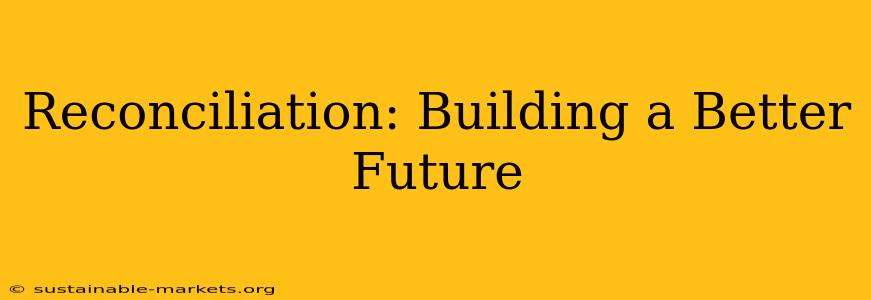Reconciliation is a complex process, encompassing far more than a simple apology or agreement. It's a journey of healing, understanding, and rebuilding trust, crucial for individual relationships and societal progress. This process involves acknowledging past harms, addressing their root causes, and actively working towards a more just and equitable future. The path to reconciliation is rarely linear, often fraught with challenges, setbacks, and difficult conversations. However, the potential rewards – stronger relationships, healthier communities, and a more peaceful world – make the effort worthwhile.
What is Reconciliation?
Reconciliation isn't simply forgetting the past; it's actively engaging with it to create positive change. It involves acknowledging the harm caused, accepting responsibility (where appropriate), and working collaboratively to heal the wounds left behind. This requires empathy, understanding, and a willingness to listen to and learn from different perspectives. It’s a multifaceted process, unique to each context, whether it's between individuals, groups, or nations.
What are the Steps Involved in Reconciliation?
The journey towards reconciliation is rarely straightforward and varies considerably depending on the context. However, some common steps often emerge:
- Acknowledgement of Harm: This is the foundational step. It involves openly recognizing the injustices, wrongs, and suffering inflicted on individuals or groups in the past. This doesn't necessarily require assigning blame but acknowledging the pain experienced.
- Truth-Telling and Accountability: This step often involves uncovering the truth about past events, which may require independent investigations, public hearings, or truth and reconciliation commissions. Accountability, where appropriate, means those responsible for the harm face consequences.
- Reparations and Restorative Justice: This involves making amends for past injustices, which could include financial compensation, land restitution, or symbolic gestures of apology. Restorative justice focuses on repairing harm and restoring relationships.
- Building Trust and Understanding: This requires open dialogue, empathy, and a willingness to listen to different perspectives. It involves building bridges of understanding across divides.
- Creating a Shared Future: The ultimate goal of reconciliation is to build a future where past harms are not repeated and where all members of society can live together in peace and justice. This requires ongoing commitment and effort.
How is Reconciliation Different from Forgiveness?
While often used interchangeably, reconciliation and forgiveness are distinct concepts. Forgiveness is a personal process, focusing on letting go of resentment and anger towards an individual who has harmed you. Reconciliation, however, is a broader process involving acknowledging harm, addressing its causes, and rebuilding relationships on a more equitable foundation. Forgiveness is possible without reconciliation, but genuine reconciliation usually requires a degree of forgiveness.
What are the Challenges in Achieving Reconciliation?
The path to reconciliation is often filled with obstacles:
- Denial and Resistance: Some individuals or groups may refuse to acknowledge past harms or accept responsibility for their actions, hindering the process.
- Lack of Trust: Deep-seated mistrust can make it difficult to engage in open dialogue and build bridges.
- Power Imbalances: Existing power imbalances can prevent equitable participation in the reconciliation process.
- Differing Narratives: Conflicting accounts of past events can complicate the process of establishing a shared understanding.
- The passage of time: The further removed an event is from the present, the harder it can be for those involved to find common ground.
What are the Benefits of Reconciliation?
Despite the challenges, the benefits of successful reconciliation are substantial:
- Improved Relationships: It strengthens relationships between individuals, groups, and nations.
- Social Healing: It promotes social healing and reduces conflict.
- Increased Trust and Cooperation: It fosters trust and cooperation within communities.
- Social Justice: It helps achieve a more just and equitable society.
- Economic Development: In some cases, it can lead to economic development and increased prosperity.
How can I contribute to Reconciliation?
Even on a personal level, you can contribute to reconciliation efforts:
- Engage in active listening: Truly hear and understand others’ perspectives, even if they differ from your own.
- Emphasize empathy: Try to understand the feelings and experiences of others, especially those who have been harmed.
- Promote open dialogue: Facilitate conversations that foster understanding and bridge divides.
- Support organizations dedicated to reconciliation: Many organizations work to promote reconciliation at both local and global levels. Their efforts help bring about positive change.
- Educate yourself and others: Learn about the history of conflict and reconciliation efforts in your community and around the world.
Reconciliation is a long-term commitment that requires perseverance and a willingness to engage in difficult conversations. While challenging, it’s a necessary process for building a better and more just future for all.

